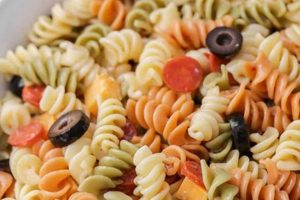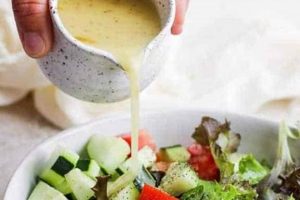A blend of sweet and tangy flavors, this type of dressing typically combines oil (often vegetable or canola), an acidic component like vinegar or lemon juice, and the characteristic poppy seeds. Variations may include sweeteners like honey or sugar, and additional flavorings such as Dijon mustard, onion powder, or garlic. A classic example features a base of white vinegar and sugar, providing a stark contrast to the subtle nuttiness of the seeds.
Its versatility makes it a popular choice for a range of salads, from fruit salads to those featuring spinach, lettuce, or cabbage. The small, black seeds offer a pleasant textural element, while their subtle, earthy flavor complements both sweet and savory ingredients. Historically, poppy seeds have been valued not just for culinary applications, but also for their medicinal and symbolic properties in various cultures. This rich history adds depth to the seemingly simple dressing.
Further exploration will delve into diverse formulations, ranging from classic preparations to innovative variations. Nutritional information, tips for optimal storage, and suggestions for pairing with specific salad ingredients will also be addressed.
Tips for Poppy Seed Dressing
Creating exceptional poppy seed dressing involves attention to detail and an understanding of flavor balancing. The following tips offer guidance for optimal preparation and enjoyment.
Tip 1: Freshly Ground Seeds: While pre-ground poppy seeds are available, freshly grinding them enhances their flavor and aroma significantly. A dedicated spice grinder or mortar and pestle yields the best results.
Tip 2: Balancing Sweet and Tangy: Achieving the right balance between sweetness and acidity is crucial. Taste and adjust the proportions of sugar or honey and vinegar or lemon juice according to preference.
Tip 3: Emulsification for Texture: Proper emulsification creates a smooth, creamy texture. Whisk the ingredients vigorously or use a blender to combine the oil and acidic components thoroughly.
Tip 4: Quality Ingredients: The quality of ingredients directly impacts the final flavor. Opt for high-quality oil, vinegar, and sweeteners for the best results.
Tip 5: Storage for Freshness: Store leftover dressing in an airtight container in the refrigerator for up to one week. Shake well before serving, as separation may occur.
Tip 6: Experimentation with Flavors: Don’t hesitate to experiment with additional flavors like Dijon mustard, garlic powder, onion powder, or a pinch of cayenne pepper to personalize the dressing.
Tip 7: Consider Seed Density: Poppy seeds can sometimes sink to the bottom of the dressing. A small amount of xanthan gum or a touch of cornstarch can help maintain a more even distribution.
By following these tips, one can consistently create flavorful and well-balanced poppy seed dressing to complement a variety of salads.
This exploration of preparation tips concludes the main discussion of poppy seed dressing. The following section offers final thoughts and a summary of key takeaways.
1. Ingredients
The quality and combination of ingredients directly influence the final character of a poppy seed salad dressing. Understanding the role of each component allows for informed choices and facilitates customization based on individual preferences.
- Oil
The oil provides the base and contributes to the dressing’s texture and mouthfeel. Common choices include neutral oils like canola, vegetable, or grapeseed oil. Extra virgin olive oil imparts a more distinct flavor. The oil’s flavor profile should complement, not overpower, the other ingredients.
- Acid
Acidity balances the richness of the oil and provides a tangy counterpoint to the sweetness. Vinegar is frequently used, with white wine vinegar and apple cider vinegar being popular choices. Lemon or lime juice offers a brighter, citrusy alternative. The level of acidity affects the overall balance and should be adjusted to taste.
- Sweetener
Sweeteners contribute to the characteristic sweet-tart flavor profile. Granulated sugar is a common choice, while honey or maple syrup offer distinct flavor nuances. The amount of sweetener used depends on the desired level of sweetness and the acidity of the other components.
- Poppy Seeds
Poppy seeds are the defining ingredient, providing a subtle nutty flavor and a pleasant textural element. Using high-quality poppy seeds, preferably freshly ground, enhances their flavor contribution. The amount of poppy seeds affects both the flavor and the visual appeal of the dressing.
The careful selection and combination of these core ingredients, along with the potential addition of other flavoring agents like mustard or spices, ultimately determine the sensory experience of the poppy seed dressing. Adjusting the proportions of each ingredient allows for customization to achieve the desired balance and complexity.
2. Proportions
Proportions play a critical role in determining the final flavor profile and texture of poppy seed salad dressing. The balance between oil, acid, and sweetener dictates whether the dressing leans towards sweet, tart, or a harmonious blend of both. The ratio of oil to acid also significantly impacts the emulsification and overall consistency. For instance, a higher proportion of oil will yield a richer, creamier dressing, while a higher proportion of vinegar results in a thinner, more vinaigrette-like consistency. A classic recipe might employ a 1:1 ratio of oil and vinegar, balanced by a carefully measured amount of sweetener.
Variations in proportions allow for tailoring the dressing to specific preferences and pairings. A sweeter dressing, achieved through a higher ratio of sweetener to acid, complements fruit salads or salads featuring milder greens like butter lettuce. Conversely, a more tart dressing, with a greater emphasis on vinegar, pairs well with robust greens like spinach or kale, or salads containing ingredients like bacon or blue cheese. Understanding these relationships empowers one to adjust a base recipe to create a dressing perfectly suited to the accompanying salad.
Mastering the interplay of proportions elevates poppy seed salad dressing preparation from a simple task to a culinary craft. The ability to manipulate ratios based on desired outcomes ensures a consistently delicious and balanced result, highlighting the importance of precision in achieving culinary excellence. Challenges may arise in achieving consistent emulsification if proportions are significantly altered, underscoring the interconnectedness of ingredients and their ratios within the recipe.
3. Emulsification
Emulsification plays a crucial role in the texture and stability of poppy seed salad dressing. It refers to the process of combining two immiscible liquids, typically oil and an aqueous solution like vinegar, into a stable mixture. A successful emulsification prevents the dressing from separating and creates a smooth, creamy consistency.
- Temporary Emulsions
In a temporary emulsion, the two liquids are combined through vigorous whisking or shaking, but they eventually separate back into distinct layers. This is often the case with basic vinaigrette-style poppy seed dressings. While a temporary emulsion can be adequately flavorful, the need for constant re-emulsification before serving can be inconvenient. An example would be a simple oil and vinegar dressing shaken vigorously before use.
- Permanent Emulsions
Permanent emulsions achieve long-term stability by incorporating an emulsifying agent. This agent, such as egg yolk or mustard, contains molecules with both hydrophilic (water-loving) and lipophilic (oil-loving) ends. These molecules surround the oil droplets, preventing them from coalescing and maintaining a uniform dispersion within the aqueous phase. Mayonnaise is a classic example of a permanent emulsion. While less common in traditional poppy seed dressings, some recipes incorporate small amounts of mayonnaise or other emulsifiers for enhanced stability.
- Factors Influencing Emulsification
Several factors influence the success and stability of an emulsion. The ratio of oil to vinegar, the viscosity of the liquids, and the presence of emulsifying agents all play a role. Temperature also affects emulsion stability; extreme temperatures can destabilize even permanent emulsions. For poppy seed dressings, finding the right balance of ingredients and employing techniques like gradual addition of oil while whisking can improve emulsification.
- Impact on Sensory Experience
Emulsification directly impacts the sensory experience of poppy seed dressing. A well-emulsified dressing coats salad ingredients evenly, providing a consistent flavor distribution. The creamy texture achieved through emulsification enhances mouthfeel and contributes to the overall enjoyment of the salad. Conversely, a poorly emulsified dressing can result in an uneven coating and a less appealing, oily mouthfeel.
In the context of poppy seed salad dressing, the desired level of emulsification depends on the specific recipe and intended use. While a temporary emulsion suffices for some preparations, the enhanced stability and sensory experience offered by a permanent emulsion are desirable for others. Understanding the principles of emulsification allows for informed choices regarding ingredients, proportions, and preparation techniques to achieve the desired outcome.
4. Flavor Balance
Flavor balance is paramount in a successful poppy seed salad dressing recipe. It represents the harmonious interplay of sweet, sour, and savory elements, creating a cohesive and enjoyable sensory experience. The delicate, nutty flavor of poppy seeds necessitates a careful calibration of other ingredients to avoid masking or overwhelming this subtle base. A dressing overly reliant on sweetness can become cloying, while excessive acidity results in a sharp, unpleasant taste. The ideal balance allows each component to contribute to the overall profile without dominating the others.
Achieving this balance involves understanding the interplay of key ingredients. The sweetness typically derives from granulated sugar, honey, or maple syrup. Acidity is introduced through vinegar (white wine, apple cider, etc.) or citrus juice. These primary flavor dimensions are further nuanced by the addition of savory elements, such as Dijon mustard, onion powder, or a pinch of salt. For example, a dressing featuring honey as a sweetener might benefit from the sharper acidity of apple cider vinegar, while a sugar-based dressing might pair well with the milder tang of white wine vinegar. The addition of Dijon mustard introduces a subtle savory complexity that complements both sweet and sour notes. These combinations demonstrate the practical application of flavor balancing principles.
Mastering flavor balance in poppy seed dressing involves not just understanding individual ingredient contributions, but also recognizing their synergistic effects. The interplay of these elements creates a dynamic profile that elevates the dressing beyond a simple condiment. Challenges can arise from variations in ingredient potency, necessitating careful adjustments based on specific product characteristics. However, a well-balanced dressing elevates the overall salad experience, demonstrating the critical role of flavor harmony in culinary endeavors.
5. Variations
Variations within poppy seed salad dressing recipes demonstrate the adaptability of a foundational formula. These modifications, ranging from subtle ingredient swaps to the incorporation of entirely new components, allow for customization based on individual preferences, dietary restrictions, and desired flavor profiles. A basic recipe, typically composed of oil, vinegar, sweetener, and poppy seeds, serves as a springboard for creative exploration. For example, substituting honey for sugar introduces a distinct floral sweetness, while replacing white vinegar with apple cider vinegar adds a subtle fruitiness. These seemingly minor alterations can significantly impact the final flavor profile.
More substantial variations involve incorporating additional ingredients to introduce layers of complexity. The addition of Dijon mustard imparts a tangy, savory note, while a touch of minced garlic or onion adds pungency. Dried herbs, such as thyme or oregano, offer herbaceous complexity. Even the type of oil utilized can influence the outcome; substituting extra virgin olive oil for a neutral oil introduces a peppery, robust flavor. These additions transform the basic dressing into a more nuanced condiment capable of complementing a wider array of salads. For instance, a poppy seed dressing infused with citrus zest and fresh herbs complements a delicate spring mix salad, while a version featuring Dijon and garlic enhances a heartier salad with roasted vegetables.
Understanding the impact of these variations enables the creation of dressings tailored to specific culinary needs. This adaptability extends the utility of the poppy seed dressing beyond a single application, allowing it to enhance diverse salads and cuisines. While challenges may arise in balancing new flavor combinations, experimentation remains key to discovering innovative and personalized variations. This flexibility underscores the dynamic nature of culinary practice, highlighting the potential for creativity within even seemingly simple recipes.
6. Storage
Proper storage is crucial for maintaining the quality and safety of poppy seed salad dressing. Because the dressing often contains perishable ingredients like oil and vinegar, specific storage practices are necessary to prevent spoilage and maximize shelf life. Improper storage can lead to undesirable changes in flavor, texture, and even the development of harmful bacteria. For example, exposure to air can cause oxidation of the oil, resulting in a rancid flavor, while temperature fluctuations can promote bacterial growth. Storing the dressing in an airtight container in the refrigerator helps mitigate these risks.
Refrigeration at temperatures below 40F (4C) is essential for inhibiting microbial growth. Airtight containers prevent oxidation and maintain the desired consistency by minimizing evaporation. Choosing appropriate containers, such as glass jars or high-quality plastic containers with tight-fitting lids, further safeguards against spoilage. While most homemade poppy seed dressings can be safely stored for up to a week in the refrigerator, commercially produced dressings may have longer shelf lives due to added preservatives. Always check the manufacturer’s recommendations for specific storage guidelines. Freezing is generally not recommended for poppy seed dressing, as it can negatively affect the emulsion and texture upon thawing.
Implementing proper storage practices ensures the dressing retains its optimal flavor, texture, and safety. Neglecting these guidelines can compromise quality and potentially pose health risks. Understanding the importance of appropriate storage contributes to a positive culinary experience and underscores the significance of food safety principles within recipe implementation. Challenges can arise from ingredient variations; dressings containing fresh ingredients, like herbs or fruits, may have shorter shelf lives. Adapting storage practices based on recipe specifics remains essential for maximizing quality and safety.
Frequently Asked Questions
This section addresses common inquiries regarding poppy seed salad dressing recipes, offering concise and informative responses.
Question 1: How long does homemade poppy seed dressing last in the refrigerator?
When stored correctly in an airtight container, homemade poppy seed dressing typically remains fresh for up to one week in the refrigerator.
Question 2: Can poppy seed dressing be frozen?
Freezing is generally not recommended, as it can negatively impact the emulsion and texture, leading to separation and a less desirable consistency upon thawing.
Question 3: What type of oil is best for poppy seed dressing?
Neutral oils like canola, vegetable, or grapeseed oil are often preferred for their subtle flavor. However, extra virgin olive oil can be used for a more robust flavor profile.
Question 4: What can be substituted for vinegar in poppy seed dressing?
Lemon or lime juice offer a suitable alternative to vinegar, providing a brighter, citrusy acidity.
Question 5: How can one prevent the poppy seeds from sinking to the bottom of the dressing?
A small amount of xanthan gum or a touch of cornstarch can help suspend the poppy seeds and maintain a more even distribution throughout the dressing.
Question 6: Can poppy seed dressing be made without sugar?
Sugar substitutes like honey or maple syrup offer alternatives for sweetness. Adjusting the amount used is important to achieve the desired flavor balance.
Addressing these frequently asked questions provides further clarity regarding the preparation, storage, and variations within poppy seed salad dressing recipes. A comprehensive understanding of these aspects empowers individuals to confidently create and enjoy high-quality dressings.
The following section concludes this exploration of poppy seed salad dressing, summarizing key takeaways and offering final recommendations.
Conclusion
Exploration of poppy seed salad dressing recipes reveals a deceptively complex interplay of ingredients, proportions, and techniques. From the foundational elements of oil, acid, and sweetener to the nuanced inclusion of additional flavoring agents, each component contributes to the final sensory experience. Emulsification principles dictate texture and stability, while careful attention to flavor balance ensures a harmonious blend of sweet, sour, and savory notes. Understanding these fundamental aspects empowers culinary practitioners to create dressings tailored to specific preferences and pairings.
The adaptability of the basic recipe, demonstrated through the myriad variations possible, highlights the potential for creativity within this seemingly simple culinary endeavor. Proper storage practices ensure the preservation of flavor and quality, maximizing the enjoyment of this versatile condiment. Continued exploration and experimentation within the realm of poppy seed salad dressing recipes promise further culinary discoveries and personalized adaptations.






